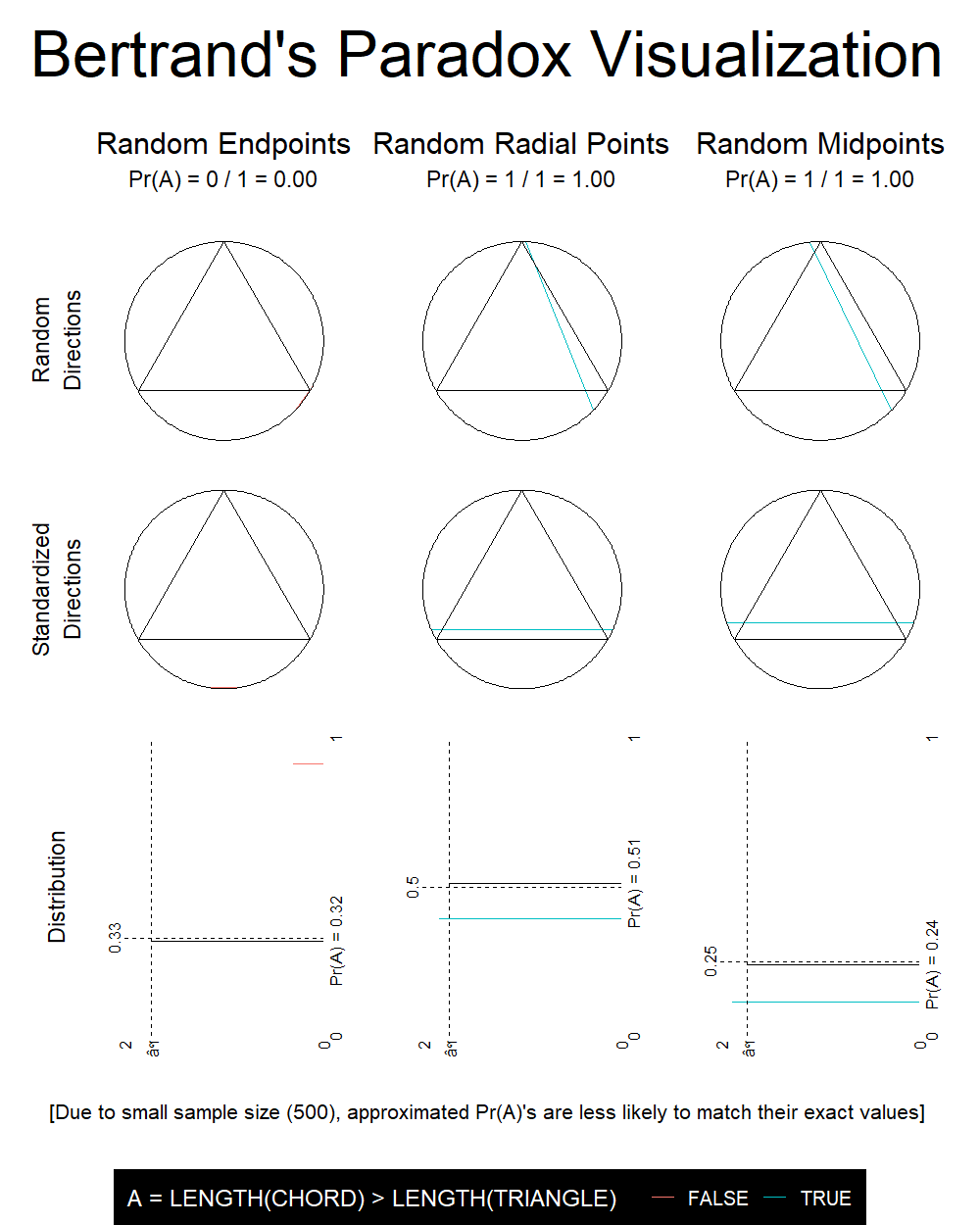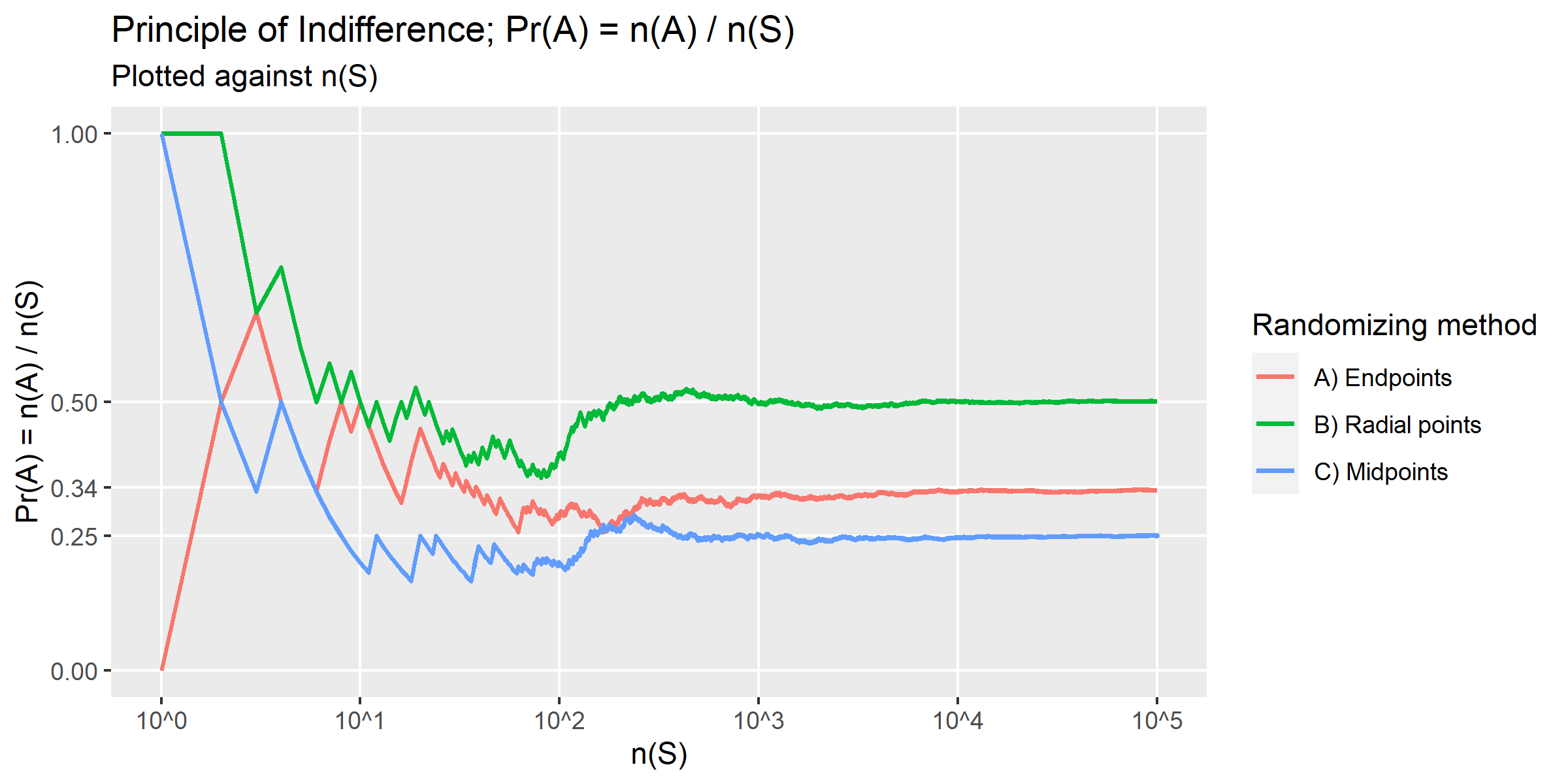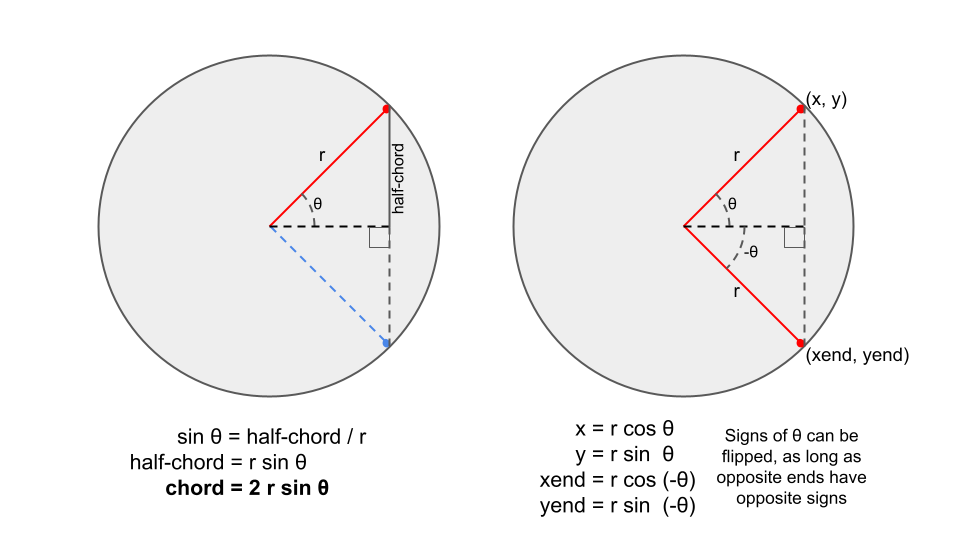| Members | |
|---|---|
| Firdaus | Wafi |
| 17B2196 | 17B2200 |
As demonstrated above, depending on the method of randomization, the value of
| Method | |
|---|---|
| Random endpoints | |
| Random radial points | |
| Random chord midpoints |
This section summarizes our approach in both solutions (empirical and visual). Elaboration of theta computations is in code elaboration section further below.
Regardless of method (A/B/C), two variables are our main concern:
- chord lengths, for computation of Pr(A)
- chord endpoints, for illustrating positions with geom_segment
Two required variables,
- theta - a vector of random angles
$[0,\pi / 2]$ - radius - standardized to 1
Computations:
# Inside tibble/dataframe
theta = runif(N, 0, pi / 2) # Method A
theta = acos(runif(N, 0, 1)) # Method B
theta = acos(sqrt(runif(N, 0, 1))) # Method C
chord_length = 2 * sin(theta) * radius
triangle_length = sqrt(3) * radius
A = chord_length > triangle_length
nA = cumsum(A)
nS = row_number()
PrA = nA/nSThree required variables,
- theta - a vector of random angles
$[0,\pi / 2]$ - radius - standardized to 1
- direction_theta - a vector of random angles
$[0, 2 \pi]$
Computations:
# Inside tibble/dataframe
theta = runif(N, 0, pi / 2) # Method A
theta = acos(runif(N, 0, 1)) # Method B
theta = acos(sqrt(runif(N, 0, 1))) # Method C
direction_theta = runif(N, 0, 2 * pi)
x = cos(direction_theta - theta) * radius
xend = cos(direction_theta + theta) * radius
y = sin(direction_theta - theta) * radius
yend = sin(direction_theta + theta) * radius
geom_segment(aes(x=x,y=y,xend=xend,yend=yend))study.com - How to Inscribe an Equilateral Triangle in a Circle has explained in detail regarding measurements of a equilateral triangle in a circle.
The relevant summary in our case (computing its length) is shown in the picture below:
The equation can be simplified as such:
Thus the code for computing any circle's corresponding equilateral triangle's side length
triangle_length <- sqrt(3) * radiusFor this method, the question instructs to choose two random points on the circumference of the circle, and draw the chord joining them.
For this, we may make use of two random variables corresponding to just the direction/angle of the pair of points from the circle's midpoint, and disregard their exact positions on the circumference as those won't be needed for further computation.
N <- 1 # Number of samples
a1 <- runif(N, 0, 2*pi)
a2 <- runif(N, 0, 2*pi)It is obvious from the picture below that directly choosing a random direction from the center is the same as selecting a random point on the circumference and computing its direction.
We may compute the difference of the two random angles by this code snippet
get_endpoint_a_diff <- function(N = 1) {
a1 <- runif(N, 0, 2*pi)
a2 <- runif(N, 0, 2*pi)
adiff <- abs(a1 - a2)
adiff[adiff > pi] <- 2 * pi - adiff[adiff > pi]
return(adiff)
}However, as illustrated above, it is evident that
- Having two random variables
$a_1 \in (0, 2\pi)$ and$a_2 \in (0, 2\pi)$ is not at all necessary as the difference between the two random angles are also uniform from$(0, 2\pi)$ - Any reflex angle
$a \in (\pi, 2\pi)$ can be expressed as its non-reflex counterpart i.e.$a' = 2\pi-a$ - Because the random distribution is uniform i.e.
$Pr(a < \pi) \approx Pr(a > \pi)$ we could then just generate$a$ from$(0, \pi)$ instead.
- Because the random distribution is uniform i.e.
get_endpoint_a_diff <- function(N = 1) {
# Angles of individual points no longer matter
# Choosing a random value from 0 to pi is sufficient
# as any reflex angle > pi would have been converted to "< pi" anyway
adiff <- runif(N, 0, pi)
return(adiff)
}However, as we would be computing the chord length via basic trigonometry, we may assume
Thus for this first method (randomize endpoints), we may simply use:
theta <- runif(N, 0, pi / 2)
chord_length <- 2 * sin(theta) * radiusFor this method, the question instructs to choose a random radius of the circle, and a random point on this radius, and draw the chord through this point and perpendicular to the radius.
However, as the selection of radius is not necessary for computing the chord length (as illustrated below), particularly in our computation method, we can skip choosing the radius.
We may then select a random point on the radius length. Or rather, compute the distance
d <- runif(N, 0, radius)Then use the distance
d <- runif(N, 0, radius)
theta <- acos(d / radius)
# Which can be further simplified as illustrated belowThus for this second method (randomize radial points), we may simply use:
theta <- acos(runif(N, 0, 1))
chord_length <- 2 * sin(theta) * radiusThe question instructs to choose a point anywhere within the circle, and construct the chord such that the point chosen is the midpoint of the chord.
We used a solution from stackoverflow - Generate a random point within a circle (uniformly) for how to decide on randomizing the position of points, which generates a random direction/angle from the center point and also a random distance from the center to the new point, in a way such that the random points would be uniformly distributed within the circle.
The reason square-root is used in randomizing distance is sufficiently explained in the top answer of the discussion, but the important points are summarized below
Same as previously, we could use the distance
d <- radius * sqrt(runif(N, 0, 1))
theta <- acos(d / radius)
# Which can be further simplified as illustrated belowThus for this last method (randomize chord midpoints), we may simply use:
theta <- acos(sqrt(runif(N, 0, 1)))
chord_length <- 2 * sin(theta) * radiusEnd of elaboration
The Bertrand paradox is generally presented as follows:
Consider an equilateral triangle inscribed in a circle. Suppose a chord of the circle is chosen at random. What is the probability
$p$ that the chord is longer than a side of the triangle?
Three different solutions are presented, each hinging on the method of generating the random chord:
-
METHOD A (random endpoints): Choose two random points on the circumference of the circle, and draw the chord joining them.
-
METHOD B (random radial points): Choose a random radius of the circle, and a random point on this radius, and draw the chord through this point and perpendicular to the radius.
-
METHOD C (random midpoints): Choose a point anywhere within the circle, and construct the chord such that the point chosen is the midpoint of the chord.
The three different methods above, all seemingly valid, yield different results for the probability in question! The exact answer can be worked out using geometric reasoning, but the goal of this assignment is to provide a visual and empirical way of calculating the probabilities.
Objective: Show, using simulation and appropriate visualisations, that the three methods above yield different
$p$ values.
As a group, you will write R code in a single .R script (named solution.R) that performs the intended solutions. This script should be able to be run without errors.
Consider the following points when writing your solutions:
-
You are free to choose the format of your solutions (
print(),cat(), data frames, tibbles, ggplots, writing functions, etc.)--but note that marks are awarded for clarity. -
Comment on your code to make its intention clearer (but don't go overboard!)
-
You may split the task among yourselves however you wish, as long as there is a proportional effort from all team members.
-
If you wish, you may present your solutions within GitHub (e.g. by appending a new section at the top of this README.md file and/or by using GitHub pages).
This assignment assumes some basic knowledge of geometry and simple probability, including but not limited to
-
The equation of a circle with radius
$r$ centred at$x_0$ and$y_0$ is given by$(x-x_0)^2 + (y-y_0)^2 = r^2$ (assuming a cartesian system of coordinates$(x,y)$ ). -
Basic trigonometry angles such as
$\sin \theta$ and$\cos \theta$ and Pythagoras theorem$a^2 + b^2 = c^2$ . -
Calculating distance between two points in 2-D space (Euclidean distance).
-
The principle of indifference: The probability
$\Pr(A)$ of an event$A$ happening is given by the ratio of the number of favourable outcomes to the total number of outcomes in the sample space. That is, in a random experiment, suppose$n(S)$ denotes the total number of outcomes, and$n(A)$ denotes the number of outcomes involving$A$ , then$$\Pr(A) = \frac{n(A)}{n(S)}.$$
In addition, you might find R's runif() function helpful for random number generation.












